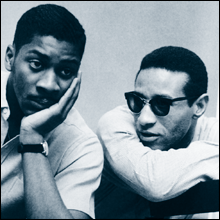![[Sidebar]](/standard/image/sidebar.gif)
![[Music Reviews]](/standard/image/headers/music_reviews_header.gif)
| clubs by night | club directory | bands in town | concerts | hot links | reviews & features |
Maxing out
Roach's hard bop hot and cool
by Jon Garelick
Booker Little and Roach
There's more to hard bop than "soul jazz" touchstones like Horace Silver's "The Preacher" and Lee Morgan's "The Sidewinder," and there's more to the Max Roach of the '50s and early '60s than hard bop. Hard bop was a general reaction against intellectualized "chamber jazz" and the West Coast "cool" school, a return to roots: blues and the music of the sanctified church, characterized by minor keys, a darker ensemble sound, and the rolling piano vamps of gospel-tinged funk. It was hotter, and self-consciously more "black." Think Charlie Parker plus Ray Charles. It was jazz of bebop sophistication with pop-song accessibility, inextricably linked to Art Blakey's Jazz Messengers and the Blue Note label.But on The Complete Mercury Max Roach Plus Four Sessions (Mosaic), you can hear how broad a reach "hard bop" could encompass. The core hard-boppers are here: Sonny Rollins, Hank Mobley, and especially Kenny Dorham. But Roach (who just turned 76 on January 10) was a first-generation bebopper (Charlie Parker's "drummer of choice," as the Mosaic liner notes point out) and had also participated in Miles Davis's Birth of the Cool sessions, which applied the bebop vocabulary to a fuller orchestral concept. And his outfit with trumpeter Clifford Brown (from 1954 until Brown's death, in 1956, in a car accident) was proto-hard bop: a sleek ensemble with hooky melodies that was the most popular jazz band of its time.
The Mosaic sides document Roach's work as a leader for the Mercury label from September 1957 through March 1960. What's immediately appealing here is the variety of musicians he worked with, the collection of stars that the box affords. Besides Rollins, Dorham, and Mobley there's the brilliant young trumpeter Booker Little (who died of kidney failure in 1961, at the age of 23), Little's Memphis compatriot George Coleman, Stanley Turrentine and his trumpet-playing brother Tommy, trombonist Julian Priester, and pianist Ray Bryant. But what's more impressive over the course of the set is the variety of textures -- each ensemble, each session, has its own character.
In many cases, this is simply a matter of changing one player in the standard quintet set-up. Over the first two and a half discs, it's Dorham's warm, lyric trumpet set against, in turn, the gruff, quizzical Rollins, the free-swinging, equally thick-toned Mobley, and then, coming as a shock, the fluid, light-toned Coleman. Coleman is soulful, and he gained heft with the years, but at this time and in this context he's as light as Stan Getz. Dorham, meanwhile, is a wonder, especially in a piece like Rodgers & Hart's "Lover," where, playing close to the mike, his stuttering syncopations are as intimate and articulate as spoken syllables.
Little, on the other hand, takes off like a rocket -- his first notable entrance came on the live recordings from the 1958 Newport Jazz Festival. This was Roach's famous "tuba band" -- Little, Coleman, bassist Art Davis, and tubist Ray Draper, then 18. Roach has dropped the piano (something he'd already tried on the Max Roach 4 Plays Charlie Parker, which is also included here). The tempos are ferocious, but Little's melodic gift comes through even in his nervous, high-register sprints.
Little contributed more than solos, though. He became an important writer for the Roach band, composing not only attractive tunes but working out tricky complex voicings for brass. And that's another thing that distinguishes Roach's bands from what often comes to mind as the hooky, "soul jazz" side of hard bop. With Parker's bands, Roach wasn't simply accommodating the leader's innovative rhythms -- he was helping to create a whole new group sound. And that's the one constant throughout the set. These aren't like a lot of the endless "blowing" sessions that come from the hard-bop era. Yes, there's plenty of "hard" blowing. And Julian Priester & Tommy Turrentine's "As Long As You're Living" is a blues over an ostinato bass that could come right out of the Jazz Messengers' book. But when the "piano-less" Roach line-up goes after the leader's "Raoul," the result has all the light, contrapuntal cool of the Mulligan/Chet Baker band. And other pieces, like some of the later compositions with trombonist Julian Priester (especially Leon Mitchell's dedication to Billie Holiday, "To Lady"), have all the coloristic complexity of The Birth of the Cool, with its polyphonic voicings for brass -- plus that hard-bop heart of darkness. Those are the kind of surprises this set turns up on side after side. Roach's "Parisian Sketches" suite shows his interest in extended forms. Even a classic stereo-era "drum battle" date like Rich Versus Roach is as notable for the arrangements by Gigi Gryce and the interplay between the two bands as for the competitive tub pounding of Buddy and Max.
Roach's drumming, as you would expect, is focused more on support, ensemble texture, and compositional integrity than on solo flash. Although his speed and dexterity are always impressive, his drumming is organic, elemental. It's no wonder that for more than 50 years he's defined the jazz heartbeat.
Mosaic releases are available by mail order only. Write to 35 Melrose Place, Stamford, Connecticut, or call (203) 327-7111, or visist www.mosaicrecords.com.
| home page | what's new | search | about the phoenix | feedback |
Copyright © 2000 The Phoenix Media/Communications Group. All rights reserved.
